Network-Level Adversaries in Federated Learning

Cristina Nita-Rotaru
Khoury College of Computer Science
Acknowledgments
• This research was supported by the Department of Defense
Multidisciplinary Research Program of the University Research Initiative (MURI) under contract W911NF -21-1-0322.
• Joint work with my colleague Alina Oprea , former students Matthew Jagielski (PhD) currently with Google Brain, Yuxuan (Ewen) Wang (undergrad) currently with Linkedin , and current students Giorgio Severi and Gokberg Yar.
• Network-Level Adversaries in Federated Learning. Giorgio Severi, Matthew Jagielski, Gokberg Yar, Yuxuan Wang, Cristina Nita-Rotaru, Alina Oprea . In IEEE CNS 2022.

Supervised Machine Learning





Learning Algorithm Model New Data New Label Training Testing Dataset Labels
Data and Machine Learning
● Data generation
○ Human input
○ Multi-sensors
○ Synthetic
● Data collection
○ Stay where it was generated
○ Collected at a central location
● Data post-processing
○ Cleaning
○ Labeling
● Machine learning setting
o Supervised machine learning
o Unsupervised machine learning
● Machine learning task
o Classification
o Regression
● Machine learning algorithms
○ Regression (linear regression)
○ Classification (SVM, decision trees)
○ Deep learning (NN architectures)
Need for Collaborative Learning
• Insufficient observations
○ Data at a node is insufficient to learn a good model

● Storage constraints
o Data too big to collect in one place
● Limited computation
o Can not perform all computation in one place
● Privacy concerns
o Data must remain where it was generated
A better model can be learned if entities collaborate!
Communication Network

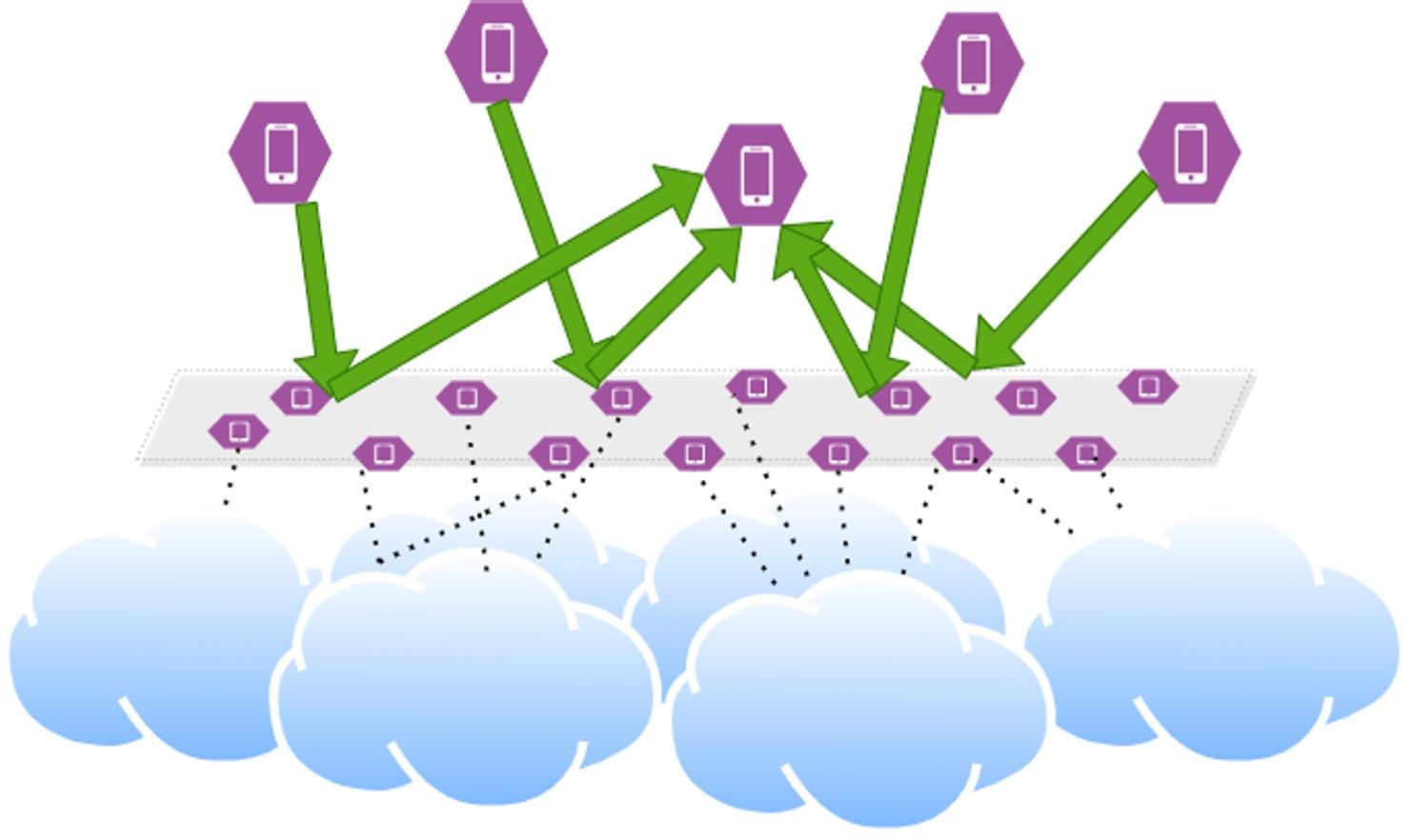
● Ensures coordination between all parties
○ Learning with partial/local information
○ Scaling
● Ensures communication between all parties
○ Data collection
○ Updates aggregation
○ Model dissemination
Federated Learning
● Clients train a machine learning model with the help of an aggregation server
○ Federated Averaging [McMahan et al. 2017]





● Training is an iterative process
○ Clients receives global model
○ Subset of clients update the model using local data and send updates to server
○ Server updates the global model by aggregating client contributions




● Benefits
○ Training data remains on client devices
○ Computational efficiency










McMahan, Brendan, et al. Communication-efficient learning of deep networks from decentralized data. Artificial Intelligence and Statistics. PMLR, 2017.

Global Model Client 4 Updated Weights Local Updates Client 3 Client 2 Client 1
P2P Federated Learning
























Client 1 Client 4 Client 2 Client 3 1 2 3 4 Round 1 Client 1 Client 4 Client 2 Client 3 Round n … Client 1 Client 4 Client 2 Client 3 1 2 3 4 Round 2 3 2 1 2 4 3 1 3
No central server
Clients (peers) collaborate to learn a personal or global model
●
○
Goals for Machine Learning
● Accuracy
● Robustness
○ Algorithms should be resilient to changes when using it on new data vs the training dataset
● Precision
● Recall
● Fairness
○ Datasets the models are trained on should be representative and avoid biases
● F-score
● MSE
● Privacy
o Use of model should not reveal information about data it was trained on
● Security
o Models should work correctly in the presence of attacks
Adversarial Machine Learning: Taxonomy
Attacks against Machine Learning

Attacker’s Objective
● Attacker’s objective
o Targets system goals
● Attacker’s capability
o Resources available
o How/when interacts with the system:
inject/change
data/model updates
● Attacker’s knowledge
o What they know
Learning stage
Targeted
Target small set of points
Training Targeted Poisoning
Backdoor
Trojan Attacks
Testing Evasion Attacks
Adversarial Examples
Availability
Target majority of points
Poisoning Availability
Model Poisoning
Privacy
Learn sensitive information
-
- Reconstruction Membership
Inference
Model Extraction
Backdoor Attack
6
Network-level Attacks
● Can impact communication directly between two parties
o Modify
o Inject
o Replay
o Drop
● Can impact communication indirectly by influencing the communication graph
o Partition the network

o Disconnect clients
o Disconnect servers
For federated learning communication is: data, local updates, updated model
Network-level Attacks against ML: Challenges
● Attacker’s goal:
o Preventing or changing communication to impact model accuracy
● Attacker’s capability
o Network partitions difficult to create and detectable
o Cryptography can prevent modification/injection
o Attack must be sustained as machine learning is iterative
● Attacker’s knowledge
o Global network information is difficult to obtain
o Channels can be encrypted
It is not clear how effective network-level attacks would be against machine learning!
In this talk
FEDEREATED LEARNING
Can an adversary with network-level capability decrease the accuracy of the machine learning models?
Can an adversary with network-level capability further amplify their attack with poisoning attacks?
Can we mitigate network-level attacks?
Federated Learning: Attacker Model




observeonlyasmallsubsetoftheparticipatingclients,and showthatourattacksarestilleffective,forinstanceinflicting a43%relativeaccuracydropwhenobservingonlyathirdof
● Attacker Goal
numberof TL
epochs.Theserverupdatestheglobalmodel f
○ Reduce accuracy on a target class
● Attacker Capabilities
Federatedlearningsystemownersdonotusuallycontrol theunderlyingnetworkandmightnotbeabletoimplement network-levelmitigationstomakecommunicationmoreresilient.Complementarytosuchnetwork-leveldefenses,we proposeaserver-leveldefensethatisagnostictohowthe droppingattackisperformed.Ourdefensemodifiesclient samplingineachroundofFLtrainingtoincreasethelikelihood ofselectingclientswhosentusefulupdatesinpreviousrounds oftheprotocol,whiledecreasingtheprobabilityofselecting lessrelevantclients.Interestingly,defensiveclientselection
○ Attacker can interfere with the delivery of model updates or the global model weights


Algorithm1: FederatedAveragingProtocol
















○ Attack can be amplified by compromising a few clients and modifying their updates
Data: Clients C = {Di }n i=1 ,FederatedLearningServer S , rounds T ,clientsperround m,aggregationlearning rate ⌘
● Attacker Knowledge
f0
= I
○ Attacker has access to global model in each round. (Federated learning is an open system, the attacker can participate as one of the clients.)
(C ,m)
Global Model Client 4 Updated Weights Local Updates Client 3 Client 2 Client 1
leveragesthesameprocedureforclientidentificationemployed bythenetwork-leveladversary.Thedefenseisextremelyeffectiveagainstatargeteddroppingattack.Forinstance,inthesame textclassificationtaskmentionedabove,whileanunmitigated t bymeanaggregationoflocalupdates Ui : ft = ft 1 + ⌘ Pm i=1 Ui m .
DataprivacycanbefurtherenhancedinFLbysecureaggregationperformedviaMulti-PartyComputation(MPC)[19].
NITIALIZE
ODEL
Function FedLearn(S, C ): //Functionrunbyserver
M
() for t 2 [1,T ] do
Mt = S ELECT PARTICIPANTS
R EQUEST U PDATE (ft 1 ,Mt ) Ut = R ECEIVE U PDATE (Mt )
fi = U PDATE M ODEL (ft 1 ,Ut , ⌘ ) B ROADCAST M ODEL (ft , C )
//Getupdatesfrom m participantsinround i
//Updateandsendoutnewmodel
Attacker Capabilities
Dropping attacks
● The attacker drops data for a subset of clients and prevent their updates from getting to the server
○ Random dropping: Selection of random victim clients and dropping their messages
○ Targeted dropping: Identifying clients whose updates contribute significantly to the target class
Model poisoning attacks
● The attacker compromises a subset of clients
● They can send malicious updates by performing model poisoning attacks
● Previous work studied model poisoning in isolation [Bagdasaryan et al. 2020, Bhagoji et al. 2019], but we are interested in amplifying network-level attacks
Network Attack Model
● COMM_PLAIN : All communication between clients and server is unencrypted
○ Network-level adversary obtains maximum information, as they can observe all the transmitted data
○ Most powerful adversary, useful for evaluating defenses
● COMM_ENC : All communication between clients and server is encrypted
○ Network-level adversary could infer the set of clients participating in each round, but not the exact model updates they send
● COMM_ENC_LIMITED : All communication is encrypted, and adversary observes only a subset of clients (has limited visibility)
○ Most constrained and realistic adversary
Methodology: Dropping Attacks
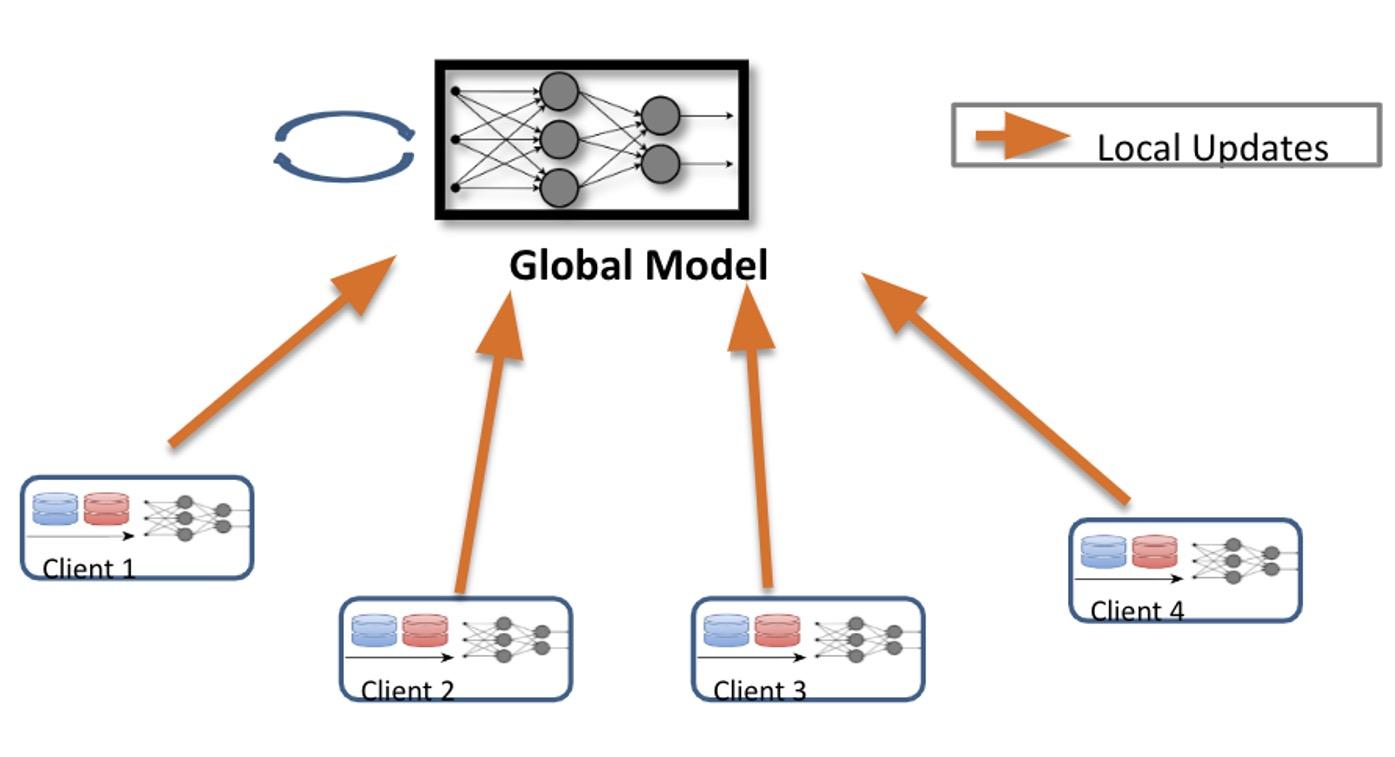
● Naive strategy: Drop updates from randomly selected clients
● Main observation: Clients do not contribute equally to the target class
○ Data is non-iid in FL deployments [Kairouz et al. 2019]
● Insight: Design Client Identification method to identify the top performing clients for target class
○ Observe client updates for a number of rounds before dropping
○ Results in more effective targeted dropping strategy
Clients 2 and 4 contribute to target class
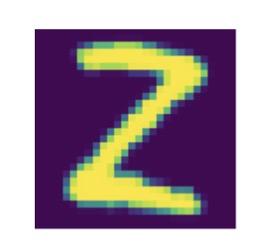 Target class
Target class
Client Identification:
● COMM_PLAIN: The attacker can observe individual clients’ updates
● Strategy: compute the model loss difference before and after a client’s update on target class
○ Repeat for multiple rounds
○ Rank clients by largest difference in loss across rounds
● Challenge: How to handle encrypted communication?
Time t: Model wt

Previous global model

Validation dataset for target class
Local update of client i

COMM_PLAIN
Client Identification: COMM_ENC
● COMM_ENC: The attacker cannot observe individual clients’ updates, only global model aggregates
● Strategy: compute the model loss difference using the previous and current aggregated global models

○ Apply the loss difference to all participating clients in current round
○ Repeat for multiple rounds
○ Rank clients by largest difference in loss across rounds
○ Requires more observation rounds than COMM_PLAIN
Time t: Model wt
Previous global model
Current global model

Client Identification: Parameters

● How many clients to drop?
○ Tradeoff between attack success on target class and remaining stealthy on other data

● How many observation rounds are needed to identify top clients?
○ Wait number of rounds so that all clients of interest are observed at least once
○ Use coupon collector for analysis: O(n/m log n), where n is total number of clients and m is number of clients sampled per round
Target class
Evaluation Setup
Target distribution
● One of the classes in the dataset (0, 1, or 9)
● Assume k clients have examples from target class, k = {9,12,15}
● Heterogeneous data: the k clients have 50% of examples from target class, and the rest are sampled with Dirichlet distribution
Dataset / Modality Task/Classes Model FL Parameters EMNIST Images Digit recognition 10 CNN 100 clients 1000 samples each FashionMNIST Images Image recognition 10 CNN 60 clients 400 samples each DBPedia Text Text classification 14 GloVE embedings and one-dimensional CNN 60 clients 1000 samples each
Client Identification Results
Average number of identified clients for target class 0, k=15 clients
● Findings:
○ Under COMM_PLAIN all clients are identified for DBPedia after 20 rounds
○ Fewer clients identified under COMM_ENC, but still on average more than 2/3 of clients are identified for DBPedia after 50 rounds
○ Number of rounds for convergence is 100 for EMNIST and 200 for DBPedia
Network Communication Dataset T=5 T=10 T=15 T=20 T= 50 T=70 COMM_PLAIN EMNIST 4.25 9.5 11.5 12.0 14.0 14.0 DBPedia 8.0 13.25 13.75 15.0 15.0 15.0 COMM_ENC EMNIST 3.0 4.0 4.0 3.75 5.75 7.0 DBPedia 5.25 7.0 8.0 9.0 11.25 11.75
Targeted Dropping for COMM_PLAIN
• Baseline: randomly drop the same number of clients
• For some datasets (DBPedia). targeted dropping of k/3 clients is catastrophic
• Overall model accuracy remains similar to original before attack
• Results are similar for COMM_ENC: k/3 dropping results in 0.38 accuracy on FashionMNIST and 0.06 accuracy on DBPedia
Dataset Acc Dropped k/3 Dropped 2k/3 Dropped k Random Targeted Random Targeted Random Targeted EMNIST 0.80 0.82 0.74 0.81 0.50 0.82 0.02 FashinMNIST 0.55 0.53 0.23 0.53 0.03 0.5 0.00 DBPedia 0.53 0.54 0.01 0.47 0.00 0.45 0.00
Accuracy on target class for k=15 clients
Targeted Dropping and Model Poisoning COMM_PLAIN
COMM_ENC
Use backdoor attack [Gu et al. 2017] with model poisoning [Bagdasaryan et al. 2020], [Sun et al. 2019]
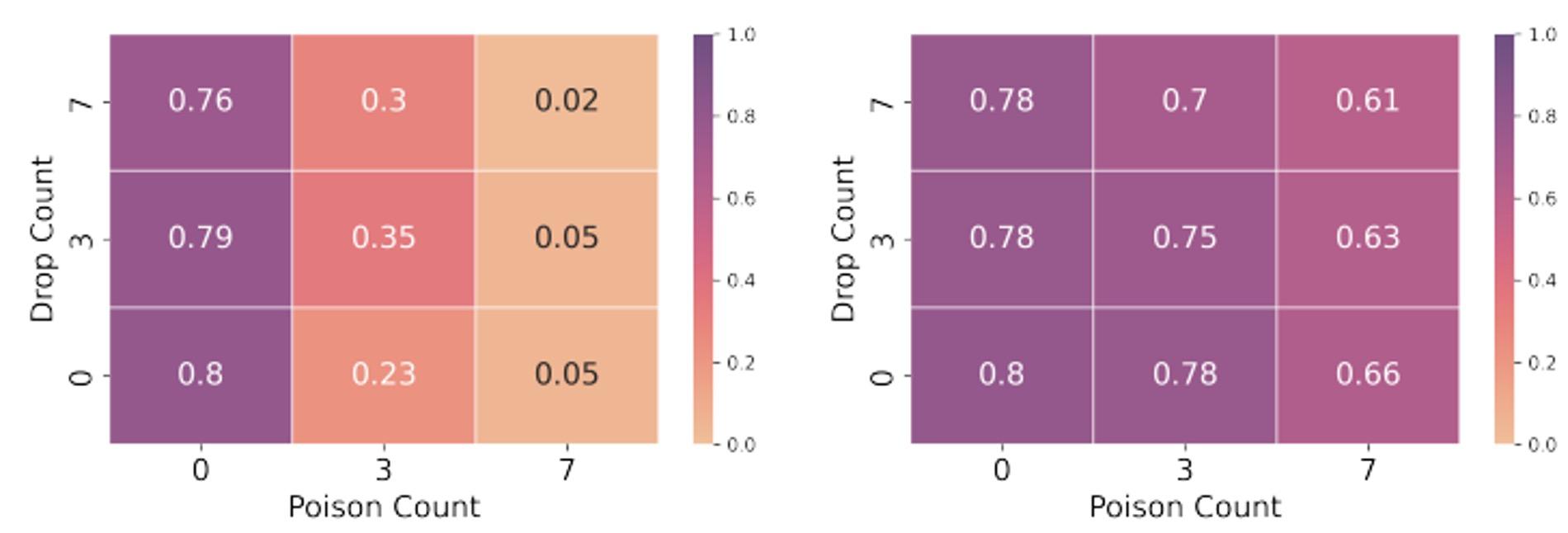
T=100
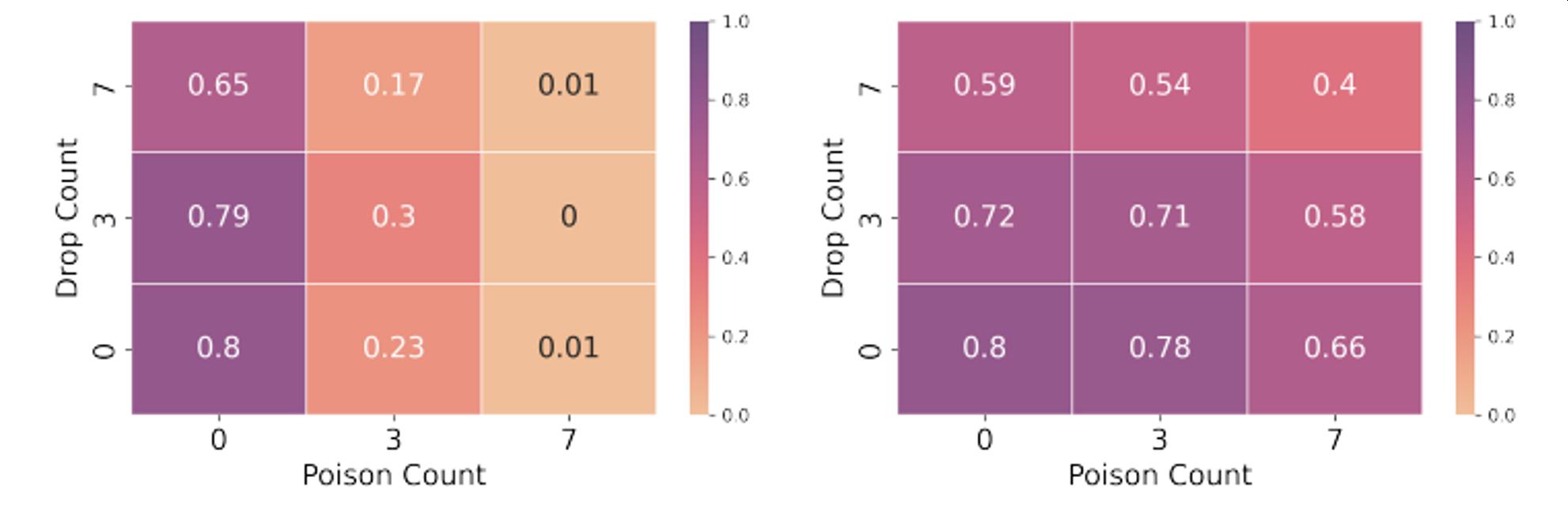
FedAvg, No clipping FedAvg, with Clipping
Limited Adversarial Visibility
● COMM_ENC_LIMITED
○ Adversary observes a subset of clients (between 10 and 60 on x axis)
○ Parameter alpha (y axis) controls how many clients from the observed subset are from the target distribution
● Attack is successful even under limited visibility!

and Poison
Drop Drop
Stronger attack
In this talk
Can an adversary with network observability capability influence the machine learning model in federated learning?
Can an adversary with network observability capability amplify his attack?
Can we mitigate network-level attacks in federated learning?
Defense: UpSampling
● Key insight
○ Use the same Client Identification procedure to identify important clients for the target class
○ Server knowledge
■ Individual client models under both COMM_PLAIN and COMM_ENC
■ Aggregated models under MPC

● UpSampling Defense
○ Server runs Client Identification to rank clients
○ Increase sampling weight proportional to rank
○ Can be combined with network -level defenses [Awerbuch et al. 2008, Obenshain et al. 2016] and poisoning defenses, e.g., gradient clipping [Sun et al. 2019]
Target class
Sample with higher probability

Defense Evaluation
Defense restores accuracy for COMM_ENC
Very strong attack

In this talk
Can an adversary with network observability capability influence the machine learning model in federated learning?
Can an adversary with network observability capability amplify his attack?
Can we mitigate network-level attacks in federated learning?
What about attacks against P2P federated learning ?
Centralized vs P2P Federated Learning








● Server acts as central aggregator
● Server is a single point of failure
● Asymmetric resources
● Communication is point to point
● Learning is through central aggregator
● No central trusted aggregator
● No single point of failure
● Symmetric resources at each peer




















● Communication is multi-hop
● Learning is through a graph
Client 1 Client 4 Client 2 Client 3 Global Model Client 4 Updated Weights Local Updates Client 3 Client 2 Client 1
Communication and Learning Graphs
• Communication network: failures, partitions
• Physical network: real network
• Logical network: overlay, may share physical links
• Learning network: bootstrapping, convergence
• Input peers: peers each node is learning from
• Output peers: peers a node shares its model with
Dependencies and trade-offs between the learning network and the communication network

Attack Surface
• Data level attacks
• Poisoning attacks
• Model level attacks
• Model poisoning
• Learning network
• Impact the learning network by exploiting the rules that manage it to target specific nodes; resources consumption attacks
• Physical network attacks
• Impact the physical network to create disturbances in the logical communication network
• Logical communication network
• Infiltrate the logical network if the system is large or nodes have high-mobility so sybill attacks are possible Ongoing work, stay tuned!
Summary
● Showed that network-level attacks can impact accuracy of machine learning
o Client Identification method that ranks clients by their contributions to the target class
o Attack effective even when communication is encrypted and attacker can observe only a subset of clients
● Proposed UpSampling defense that modifies server-side sampling
● Performed evaluation on multiple datasets from image and text modalities
https://github.com/ClonedOne/Network-Level-Adversaries-in-Federated-Learning
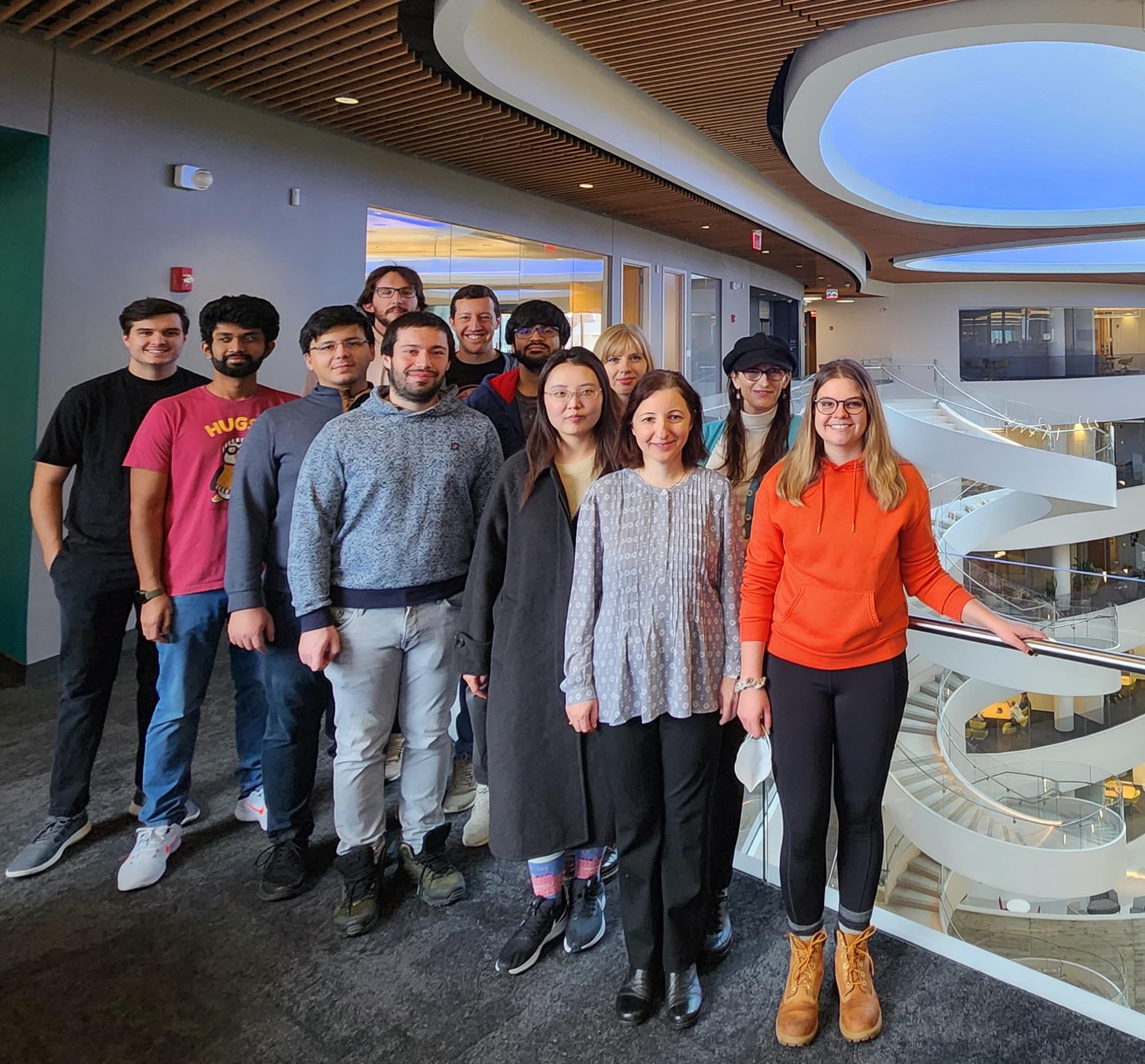
NDS2 Lab, Nov. 2022





























 Target class
Target class





















